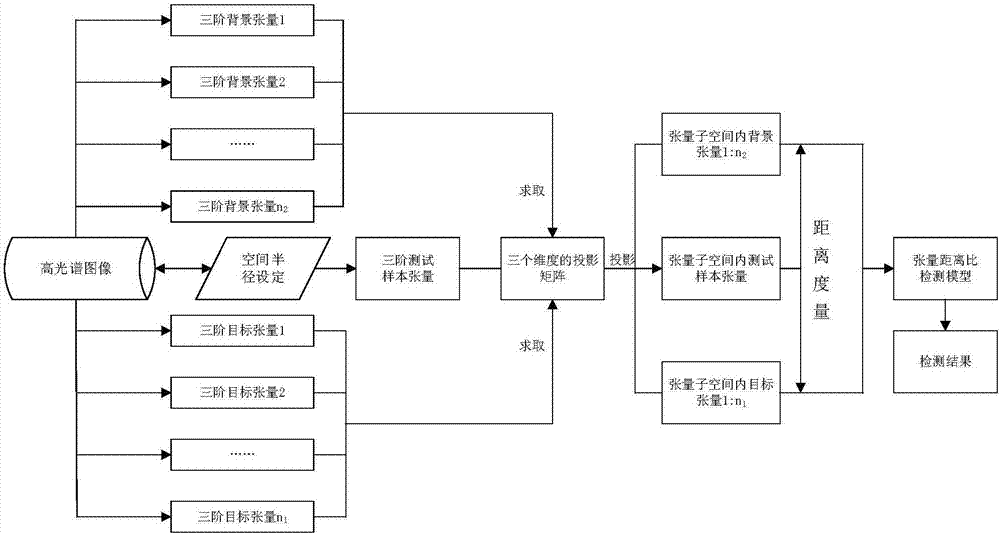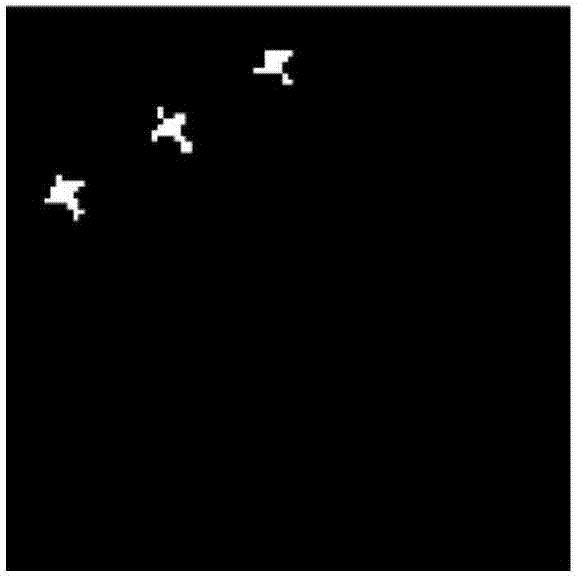Hyperspectral image target detection method based on tension linear discrimination analysis dimension reduction
A linear discriminant analysis and hyperspectral image technology, applied in the field of hyperspectral image target detection, can solve the problems of inability to mine 3D data information and low detection accuracy
- Summary
- Abstract
- Description
- Claims
- Application Information
AI Technical Summary
Problems solved by technology
Method used
Image
Examples
specific Embodiment approach 1
[0030] Specific implementation mode one: combine figure 1 To illustrate this embodiment, the specific process of the hyperspectral image target detection method based on tensor linear discriminant analysis dimensionality reduction in this embodiment is as follows:
[0031] Step 1: Select and divide the tensor block of the hyperspectral image to be detected, and obtain the empty X-empty Y-spectrum third-order target tensor block, empty X-empty Y-spectrum third-order background tensor block and empty X- Empty Y-spectrum third-order test sample tensor block to be detected;
[0032] Step 2: Set the size of the target tensor block, background tensor block and test sample tensor block to be tested in each dimension after projection, and use the target tensor block and background tensor block obtained in step 1 to train and obtain the target The three-dimensional projection matrix of the tensor block, the background tensor block and the test sample tensor block to make the target t...
specific Embodiment approach 2
[0036] Specific embodiment 2: The difference between this embodiment and specific embodiment 1 is that in the first step, the hyperspectral image to be detected is selected and divided into tensor blocks, and the third-order target tensor of empty X-empty Y-spectrum is obtained Block, empty X-empty Y-spectrum third-order background tensor block and empty X-empty Y-spectrum third-order test sample tensor block to be detected; the specific process is:
[0037] Given a 3×3 window, convert the hyperspectral image to be detected into a third-order tensor form, slide the sampling window, and determine it as empty X-empty when the value of the truth map corresponding to the center point of the sampling window is 1 Block of Y-spectral third-order target tensors from which n is arbitrarily sampled 1 get an empty X-empty-Y-spectrum third-order target tensor block When the values of all points in the window corresponding to the truth map are 0, it is determined to be an empty X-empty...
specific Embodiment approach 3
[0039] Specific embodiment three: the difference between this embodiment and specific embodiment one or two is that in the step two, the target tensor block, the background tensor block and the test sample tensor block to be detected are set in each dimension after projection The size of the target tensor block and the background tensor block obtained in step 1 are trained to obtain the projection matrix in the three dimensions of the target tensor block, the background tensor block and the test sample tensor block to be detected, so that the target tensor Blocks and background tensor blocks have maximum separability in the projected subspace; the specific process is:
[0040] Step 21, the target tensor block obtained in step 1 and the background tensor block As two-class training tensor samples Set the target tensor block, the background tensor block and the test sample tensor block to be tested. The size of the projected dimension of each dimension of the block is take...
PUM
 Login to View More
Login to View More Abstract
Description
Claims
Application Information
 Login to View More
Login to View More - R&D
- Intellectual Property
- Life Sciences
- Materials
- Tech Scout
- Unparalleled Data Quality
- Higher Quality Content
- 60% Fewer Hallucinations
Browse by: Latest US Patents, China's latest patents, Technical Efficacy Thesaurus, Application Domain, Technology Topic, Popular Technical Reports.
© 2025 PatSnap. All rights reserved.Legal|Privacy policy|Modern Slavery Act Transparency Statement|Sitemap|About US| Contact US: help@patsnap.com



